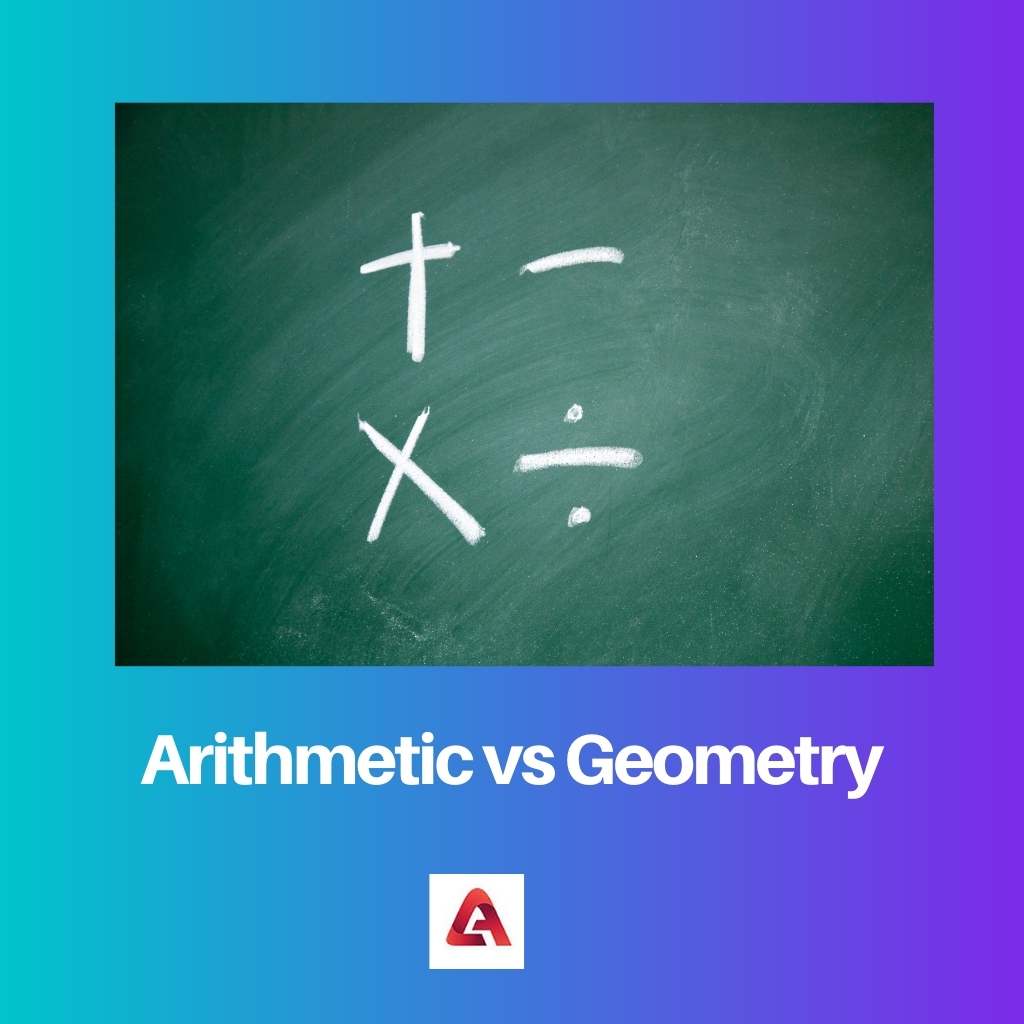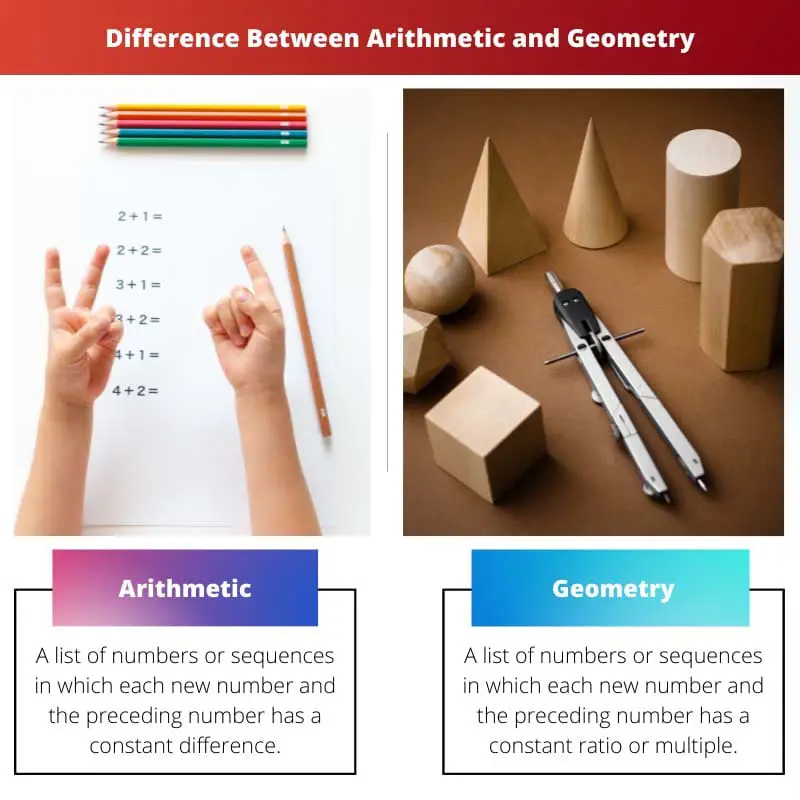Mathematics is something not everyone is good at, but it is something that is essential in our everyday life. Mathematics is not just about solving problems on paper but using theories in real-life scenarios.
There are various branches and sub-branches of mathematics. Two of them include Arithmetic and Geometry.
Key Takeaways
- Arithmetic studies numbers and their operations, such as addition, subtraction, multiplication, and division.
- Geometry studies objects’ shapes, sizes, positions, and dimensions in space.
- Arithmetic involves solving equations and working with numerical data, whereas geometry involves working with shapes, angles, and measurements.
Arithmetic vs Geometry
Arithmetic is a branch of mathematics that deals with numbers and numerical computation, including operations like addition, subtraction, multiplication, and division. Geometry is the study of shapes, sizes, properties of space, and the relationships between different shapes.

Arithmetic refers to a subdivision of mathematics consisting of number studies, including basic addition and subtraction. Number theory is among the top-level decisions of modern-day mathematics.
The others include geometry, algebra, and analysis. And an elementary part of this number theory is Arithmetic.
Geometry refers to another branch or subdivision of mathematics associated with the study of sizes, shapes, positions, angles, and the dimensions of different objects. Geometer is an individual working in the field of geometry.
Geometry can be traced back to the 2nd millennium BC in ancient Egypt and Mesopotamia.
Comparison Table
| Parameters of Comparison | Arithmetic | Geometry |
|---|---|---|
| Meaning | A list of numbers or sequences in which each new number and the preceding number has a constant difference. | A list of numbers or sequences in which each new number and the preceding number has a constant ratio or multiple. |
| Successive terms | There is a common difference between the two numbers. | There is a common ratio between the two numbers. |
| New term | In sequence, the new term can be obtained by addition or subtraction. | In sequence, the new term can be obtained by multiplication or division. |
| Variation | There is a linear variation of terms. | There is an exponential variation of terms. |
| Sequence Example | 0, 3, 6, 9, 12, 15 | 3, 9, 27, 81, 6561 |
| Utilization | It is a simple manipulation of numbers useful in everyday life. | It is related to properties of space associated with distance, shape, size, and relative position of objects or figures. It is useful in construction projects. |
What is Arithmetic?
Arithmetic refers to a subdivision of mathematics consisting of number studies, including basic addition and subtraction. Number theory is among the top-level decisions of modern-day mathematics.
The others include geometry, algebra, and analysis. And an elementary part of this number theory is Arithmetic. Until the 20th century, number theory and arithmetic were considered to be synonyms.
There are certain objects that showcase addition and subtraction is used, which go back to 20000 BC.
However, according to the proof, it can be stated that many of the elementary mathematical operations were used by Egyptians and Babylonians in 2000 BC. The field’s historical development later took place in Ancient Greece.
Addition, Subtraction, Multiple, and Division are the basic operations of arithmetics. The advanced ones include square and square roots, percentages, exponentials, and logarithms.
The most common symbols are ‘+’ for addition, ‘-’ for subtraction, ‘x’ for multiplication, and ‘÷’ or ‘/’ for division. Arithmetics involves a linear variation of terms.
In the Arithmetic sequence, the new term can be obtained by addition or subtraction. Arithmetics can be considered as the basis of mathematics. It is also a very integral part of our daily activities.
What is Geometry?
Geometry refers to another branch or subdivision of mathematics associated with studying different objects’ sizes, shapes, positions, angles, and dimensions. Geometer is an individual working in the field of geometry.
Geometry can be traced back to the 2nd millennium BC in ancient Egypt and Mesopotamia.
Geometry at these early stages consisted of principles relating to lengths, angles, areas, and volumes. These principles were developed for the requirement of practical knowledge for the purpose of construction, crafts, astronomy, and surveys.
Egyptian Rhind Papyrus, Moscow Papyrus, and Babylonian clay tablets are some of the earliest recognized texts on geometry.
In terms of shapes and figures, geometry can be based on two types of objects 2D and 3D. Flat geometry is the study of 2D objects.
These objects have only 2 dimensions: circles, triangles, squares, and rectangles. Solid objects or 3D objects are objects which have height as well as depth. This adds another dimension.
These objects include spheres, cones, cubes, and cuboids. In geometry, angles are of crucial importance. An angle is a vertex formed by any two rays or sides. In every arithmetic sequence, there is a common ratio. Geometry involves exponential variation.
Main Differences Between Arithmetic and Geometry
- Arithmetic relates to a list of numbers or sequences in which each new and preceding numbers have a constant difference. Geometry relates to a list of numbers or sequences in which each new number and the preceding number have a constant ratio or multiple.
- There is a common difference between two numbers in the Arithmetic sequence. There is a common ratio between two numbers in Geometry.
- The new term can be obtained by addition or subtraction in the Arithmetic sequence. In a Geometric sequence, multiplication or division can obtain the new term.
- There is a linear variation of terms in Arithmetics. There is an exponential variation of terms in Geometry.
- Example of Arithmetic sequence- 0, 3, 6, 9, 12, 15. Example of Geometric sequence– 3, 9, 27, 81, 6561
- Arithmetics is a simple manipulation of numbers useful in everyday life. Geometry is related to the properties of space associated with distance, shape, size, and relative position of objects or figures. It is useful in construction projects.

- https://link.springer.com/article/10.1007/BF00367686
- https://books.google.com/books?hl=en&lr=&id=PgHjLgIVidgC&oi=fnd&pg=PR13&dq=arithmetic+and+geometry+mathematics&ots=HsbtfxW4Dx&sig=q3df3gYh3j-7nuppRRj3VWOLL-k

Marvelous explanation of arithmetic and geometry. I can see why teaching these two is highly beneficial to intelligence. In the non-abstract world, these two are required for everyday activities. Additionally, the historical background also helped me expand my perspective.
Completely agree, Edwards. The definition and explanation are pretty comprehensive. Outstanding approach in terms of maintaining geometry and arithmetic. A great read!
The references are highly informative. However, the details of the references could have been more thorough.
Zrussell, I concur. Although the references make an outstanding initiative, a more detailed approach would have made the post more credible.
The comparison table is quite beneficial in understanding the fundamental differences. Nonetheless, there are also some similarities that I wish would have been elaborated on.
I understand your confusion, Elsie. The author could have detailed more about the similarities. However, it’s remarkable how a lot of information is compiled in one post.
Good point, Elsie. Although there are differences, quite a few similarities exist as well which contribute to certain confusions.
The logical comparison between arithmetics and geometry is highly thought-provoking. Nevertheless, the historical aspects presented are mind-boggling.
Praiseworthy elaboration on arithmetic and geometry. I have gained a lot of useful understanding.
I find number theory to be quite interesting but at the same time a daunting task to deal with. It’s essential to evolve our understanding of geometry and arithmetic, and this article precisely does that.
Neil, I slightly disagree with the practical implications part but I concur with the rest of your comment. It is certainly a thought-provoking post. We should all be grateful for the free resources available.
Indeed, the article excellently outlines the fundamental concepts. It produces a stimulating conversation on the subject. But, I believe it may have missed out on some practical implications.